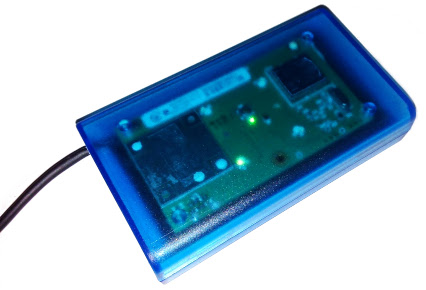This is an old revision of the document!
Table of Contents
DIY Xbox 360 PC wireless receiver with MSP430 control
Abstract
Xbox 360 wireless controller can be used with PC when special adapter is used. Xbox 360 itself has a separate RF module that communicates with motherboard through USB interface. Additional interface is used to initialize module LEDs and start sync process. One can create adapter for a fraction of cost using only several elements.
Description
Required parts:
- Xbox360 RF board
- USB cable
- MCU
- LDO (3.3 [V])
- Capacitor/resistor for MCU
Pinout of the RF board from top:
<html> <?xml version=“1.0” encoding=“UTF-8” standalone=“no”?>
</html>
Board must be powered by 3v3 so I decided to use LDO. Furthermore to start pairing process specific serial command must be sent. I have used MSP430G2231 for this task. MCU need reset pull-up resistor and decoupling capacitor. Pins 1 and 8 are connected to RF board.
Pairing process starts few seconds after device is powered. No external button needed.
#include <msp430.h> #include <stdbool.h> #define DATA 1 #define CLOCK 8 #define DTA_INPUT P1DIR &= ~DATA; #define DTA_OUTPUT P1DIR |= DATA; #define DTA_HI P1OUT |= DATA; #define DTA_LO P1OUT &= ~DATA; volatile signed short bit_counter =0; volatile unsigned short command =0; //Port 1 interrupt service routine #pragma vector=PORT1_VECTOR __interrupt void Port_1(void) { P1IFG &= ~CLOCK; // are we sending or receiving? if (bit_counter>0) { DTA_OUTPUT if (command & (1<<(bit_counter-1))) DTA_HI else DTA_LO } // stop bit! else if (bit_counter == 0) { P1OUT |= DATA; command=0; } else { DTA_INPUT if (P1IN&DATA) command |= (1<<((11+bit_counter))); else command &= ~(1<<((11+bit_counter))); } bit_counter--; } inline void send(char s) { DTA_OUTPUT command = s; bit_counter = 10; DTA_LO // Send start bit } //------------------------------------------------------------------------------ int main(void) { unsigned short delay=0; // // CLOCK // WDTCTL = WDTPW | WDTHOLD; // Stop watchdog timer if (CALBC1_1MHZ==0xFF) // If calibration constants erased { while(1); // do not load, trap CPU!! } DCOCTL = 0; // Select lowest DCOx and MODx settings BCSCTL1 = CALBC1_1MHZ; DCOCTL = CALDCO_1MHZ; // // UART // setup_uart(); // // Serial Interface // P1OUT |= DATA; // DTA HIGH P1DIR |= (1<<6); DTA_OUTPUT // DTA OUTPUT P1IES |= CLOCK; // fires on falling edge~ P1IFG &= ~CLOCK; // int cleared P1IE |= CLOCK; // int enabled // // Start // __enable_interrupt(); __delay_cycles(2000000); send(132); // LEDs active with power button on while(--delay); send(0x085); // Start animation while(--delay); while(--delay); while(--delay); while(--delay); send(0x004); // Start sync __delay_cycles(5000000); // Give some extra time to finish cmd send __disable_interrupt(); // Turn off MCU _BIS_SR(LPM4_bits); }
Notes
- There is no way to detect if controller is connected without snooping USB. Current and serial responses do not change after connection.
- RF board should be easy to get as repair shops have huge stock from broken Xboxs
References
- TI Application Report PCB-Based Capacitive Touch Sensing With MSP430 Zack Albus
- TI Application Report Capacitive Touch Sensing, MSP430™ Button Gate Time Optimization and Tuning Guide

